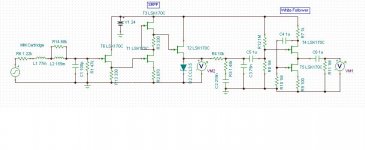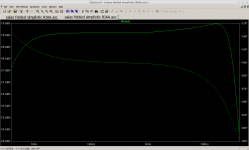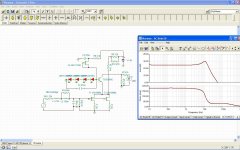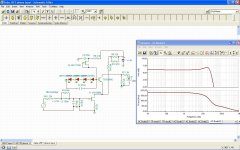My simulations show that you need a buffer between the cartridge and the first JFET gain stage. Otherwise, the response is not pretty. The spice models I'm using are from the manufacturer.
You should put all the gain up front before the passive RIAA network in order to achieve the best S/N ratio. This one has a S/N ratio of 95dB @ 1KHz. Real world would be a little less than that.
You should put all the gain up front before the passive RIAA network in order to achieve the best S/N ratio. This one has a S/N ratio of 95dB @ 1KHz. Real world would be a little less than that.
Attachments
Last edited:
Nice. BTW, grab a UNI-T UT61E somewhere online on first chance. Easier to use than your Tenma bcs its auto ranging and It has a sensitive 0.1% spec frequency counter that extends far high, plus its true RMS and 22000 counts. Can datalog on a PC also. Keep the Tenma as secondary meter and Hfe tool.
Thanks, Salas, I shall go looking for one.
Finished the speed adjustment this morning BTW. The 33/45 speed controller I am using is put out by Steve Tuckett of "Number9 TT", here in Australia. It is designed for the 24v Premotec motor which Rega uses:
* mains frequency can be programmed to 0.001Hz,
* run-voltage & startup voltage can also be adjusted,
* as can the capacitance between the 2 pairs of motor windings (to minimise motor vibration).
Steve supplies a pulley for a Rega ... but I am using the speed controller with a Linn LP12 bearing & platter - so I had to get a pulley machined to suit the LP12 dimensions.
It turns out that this pulley is very slightly oversized; using a 1,000Hz tone (which is 1,350Hz when played at 45rpm), I needed 49.35Hz to get 33 1/3rd rpm and 66.60Hz for 45rpm. I had to use a 24dB bandpass filter (centred on 1KHz - which I made using Rod Elliott's P09 PCB) on the output of the phono stage, to stabilise the DMM reading, but it worked very well. At both speeds, I was able to get the DMM display to change only between -1 and +1Hz around the desired reading!
So thanks very much for all of your advice.

Andy
I added your cartridge circuit to my Salas Folded Simplistic spice circuit. There is no problem.
Jim
It doesn't look that good to me, but opinions may differ.
Attachments
Thanks, Salas, I shall go looking for one.
Finished the speed adjustment this morning BTW. The 33/45 speed controller I am using is put out by Steve Tuckett of "Number9 TT", here in Australia. It is designed for the 24v Premotec motor which Rega uses:
* mains frequency can be programmed to 0.001Hz,
* run-voltage & startup voltage can also be adjusted,
* as can the capacitance between the 2 pairs of motor windings (to minimise motor vibration).
Steve supplies a pulley for a Rega ... but I am using the speed controller with a Linn LP12 bearing & platter - so I had to get a pulley machined to suit the LP12 dimensions.
It turns out that this pulley is very slightly oversized; using a 1,000Hz tone (which is 1,350Hz when played at 45rpm), I needed 49.35Hz to get 33 1/3rd rpm and 66.60Hz for 45rpm. I had to use a 24dB bandpass filter (centred on 1KHz - which I made using Rod Elliott's P09 PCB) on the output of the phono stage, to stabilise the DMM reading, but it worked very well. At both speeds, I was able to get the DMM display to change only between -1 and +1Hz around the desired reading!
So thanks very much for all of your advice.
Andy
Its a minimal gear method but quite handy. Good experimental result.
I added your cartridge circuit to my Salas Folded Simplistic spice circuit. There is no problem.
Jim
Still there is the mechanical aspect to consider, which varies widely between MM models. "Clearly the electrical model is not telling us the whole story" Load the Magnets!!! - [English]
You are simulating the MC configuration with an MM source model.
I'm sorry, but I don't see where it says that in your pdf document.
What's the difference?
Attachments
Read the "Notes" near the end.
OK, I changed the values as I could find them in the notes. Not much gain and still a good bump. oh well.
Attachments
From 5dB bump you went down to 0.5dB last octave bump. Which is not much there with MM carts and their mechanical issues, they struggle beyond 15-16kHz. They are responding to the R//C input loading choices much more for response shaping (#12210). Their final response is varying +/-2dB up to 15kHz at least. Total gain for two stages and filter is the 40dB standard for MM. HMC, MC, LMC are not inductively reactive enough and extend better due to lower pick up mass.
OK, I changed the values as I could find them in the notes. Not much gain and still a good bump. oh well.
If you increase the input cap (100pf) does it get better?
Hey Salas:
I'm on vacation this week, and I spent some time today listening to a selection of records with my new cart. I'm still thinking it's a bit bright. I had felt a bit that way with the previous cartridge too, but not quite so much. Part of it is a, shall we say, "sparkle", to the top end, which is actually quite wonderful, and absent from the Sumiko. But it needs to be tamed. Apart from that... WOW! This is a really nice cartridge, and shows off the FSP. Surface noise if very quiet, almost completely gone on some disks which did not sound that way with other carts. I played some very old jazz records which suddenly had a "presence" and dynamics that I have never heard before (and I've owned these records for a very long time and listened to them countless times*). Listening to a couple of very well-recorded pressings with some very natural bass, which sometimes sound a bit over the top with other carts, the bass now sounds leaner, more controlled, but still has excellent extension. I'm hearing the very low notes but not the mid-bass "bloom" that the Sumiko and the Signet had. Again, I think the dynamics are superb, and liven up some records in a way that is hard to describe.
So based on this more extensive listening I think later this week I'll pop in the extra C2Y caps and see what happens. If that tames the top end while keeping the sparkle, I will be one happy camper!
*In fact, one of those albums received countless hours of playing on an old "record changer" in a console hi-fi with a ceramic cartridge and a quarter taped to the plastic tonearm to "improve the tracking". What can I say? Gene Krupa is god!
I'm on vacation this week, and I spent some time today listening to a selection of records with my new cart. I'm still thinking it's a bit bright. I had felt a bit that way with the previous cartridge too, but not quite so much. Part of it is a, shall we say, "sparkle", to the top end, which is actually quite wonderful, and absent from the Sumiko. But it needs to be tamed. Apart from that... WOW! This is a really nice cartridge, and shows off the FSP. Surface noise if very quiet, almost completely gone on some disks which did not sound that way with other carts. I played some very old jazz records which suddenly had a "presence" and dynamics that I have never heard before (and I've owned these records for a very long time and listened to them countless times*). Listening to a couple of very well-recorded pressings with some very natural bass, which sometimes sound a bit over the top with other carts, the bass now sounds leaner, more controlled, but still has excellent extension. I'm hearing the very low notes but not the mid-bass "bloom" that the Sumiko and the Signet had. Again, I think the dynamics are superb, and liven up some records in a way that is hard to describe.
So based on this more extensive listening I think later this week I'll pop in the extra C2Y caps and see what happens. If that tames the top end while keeping the sparkle, I will be one happy camper!
*In fact, one of those albums received countless hours of playing on an old "record changer" in a console hi-fi with a ceramic cartridge and a quarter taped to the plastic tonearm to "improve the tracking". What can I say? Gene Krupa is god!
Welcome to the Denon cult. The 300 series is indeed less bombastic & projecting but finer and more resolute than the 100 series except an old model the 103D which had your type of lever & needle combining some bloom along enhanced resolution. Technically the 300 series is nearer to "flat" and the surface noise is lower than in the 100 series and many other. For the money all Denon are bargains no doubt, and always "together" musically on many genres and cuts. Just because the upper bass and lower midrange isn't as enhanced as with a 103's resonant body and lively suspension I believe the treble can take bit starker relief in a neutral system if not tuned out more persistently by loading, VTA, Riaa curve etc. On the other hand the 300 series won't need that special high mass and absorption vintage arm or silicone oil damping on a lighter one to give out its best. That "internal sparkle" you cherish is more your cart's virtue than treble quantity and I hope that by ironing out the last octave better by C2Y+ it won't go away. If the "expression" or dynamics will tame more than to your liking as a side effect, maybe 200R load could free it better due to less electrical damping on its motor. Its a 16 Ohm motor, 100 Ohm load you got is not even 10X. You would not load like that your preamp for example. When carts are overdamped electrically they tend to "pinch" a bit and withdraw in bass. Or just a change of resistor type like a Rhopoint wirewound or a Shinkoh tantalum for existing or tentative load value can be all there is you look for. Ultimately the Mundorf tin foil output caps are not what I would use even vs. their plane non oil Supreme model not to mention the Clarity MR. I find those tin foil kinda "detached" but it may just be my wrong idea. Some will tell you its their best value for money model. Keep us posted anyway bcs such info about carts choices and tuning steps is all that vinyl rig obscurity the friends here need to know more about. Congratulations on having found some new joy with a modest outlay after that dreaded Ortofon set up cantilever bust.
The 300 series is indeed less bombastic & projecting but finer and more resolute than the 100 series except an old model the 103D which had your type of lever & needle combining some bloom along enhanced resolution. Technically the 300 series is nearer to "flat" and the surface noise is lower than in the 100 series and many other. For the money all Denon are bargains no doubt, and always "together" musically on many genres and cuts. Just because the upper bass and lower midrange isn't as enhanced as with a 103's resonant body and lively suspension I believe the treble can take bit starker relief in a neutral system if not tuned out more persistently by loading, VTA, Riaa curve etc. On the other hand the 300 series won't need that special high mass and absorption vintage arm or silicone oil damping on a lighter one to give out its best. That "internal sparkle" you cherish is more your cart's virtue than treble quantity and I hope that by ironing out the last octave better by C2Y+ it won't go away. If the "expression" or dynamics will tame more than to your liking as a side effect, maybe 200R load could free it better due to less electrical damping on its motor. Its a 16 Ohm motor, 100 Ohm load you got is not even 10X. You would not load like that your preamp for example. When carts are overdamped electrically they tend to "pinch" a bit and withdraw in bass. Or just a change of resistor type like a Rhopoint wirewound or a Shinkoh tantalum for existing or tentative load value can be all there is you look for. Ultimately the Mundorf tin foil output caps are not what I would use even vs. their plane non oil Supreme model not to mention the Clarity MR. I find those tin foil kinda "detached" but it may just be my wrong idea. Some will tell you its their best value for money model. Keep us posted anyway bcs such info about carts choices and tuning steps is all that vinyl rig obscurity the friends here need to know more about. Congratulations on having found some new joy with a modest outlay after that dreaded Ortofon set up cantilever bust.
Me I did it more than once with a Fluke 87V on my 103R and once on my Dynavector 10X4 MKII and AT F5-OCC but I can't recommend it without a disclaimer since some meters can put out more test current and fuse a motor wire. About permanently magnetizing the internals its more of an urban legend I think since I have not seen any persuasive argument technically. My 103R did not change its tone after such a test at least. We don't have to measure it for longer than a split second anyway. What internal resistance the manufacturers give spec for is more or less true in most models nonetheless. In the 103R was 18 Ohm instead of 14 Ohm (more than +/-20% tolerance that Denon claims), on the others it was spot on spec.
- Home
- Source & Line
- Analogue Source
- Simplistic NJFET RIAA



